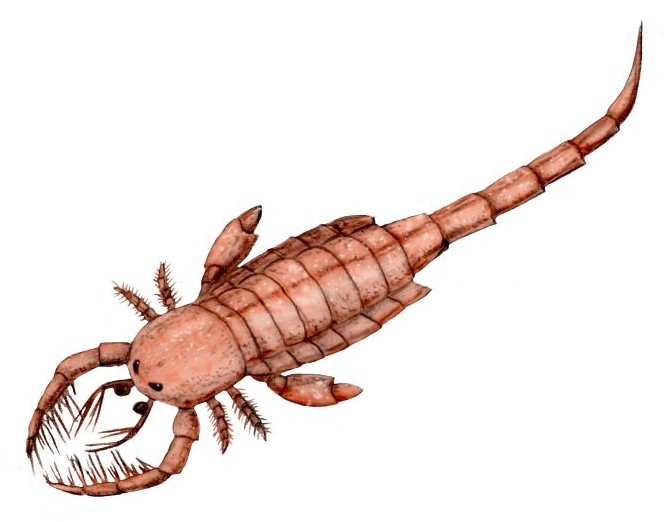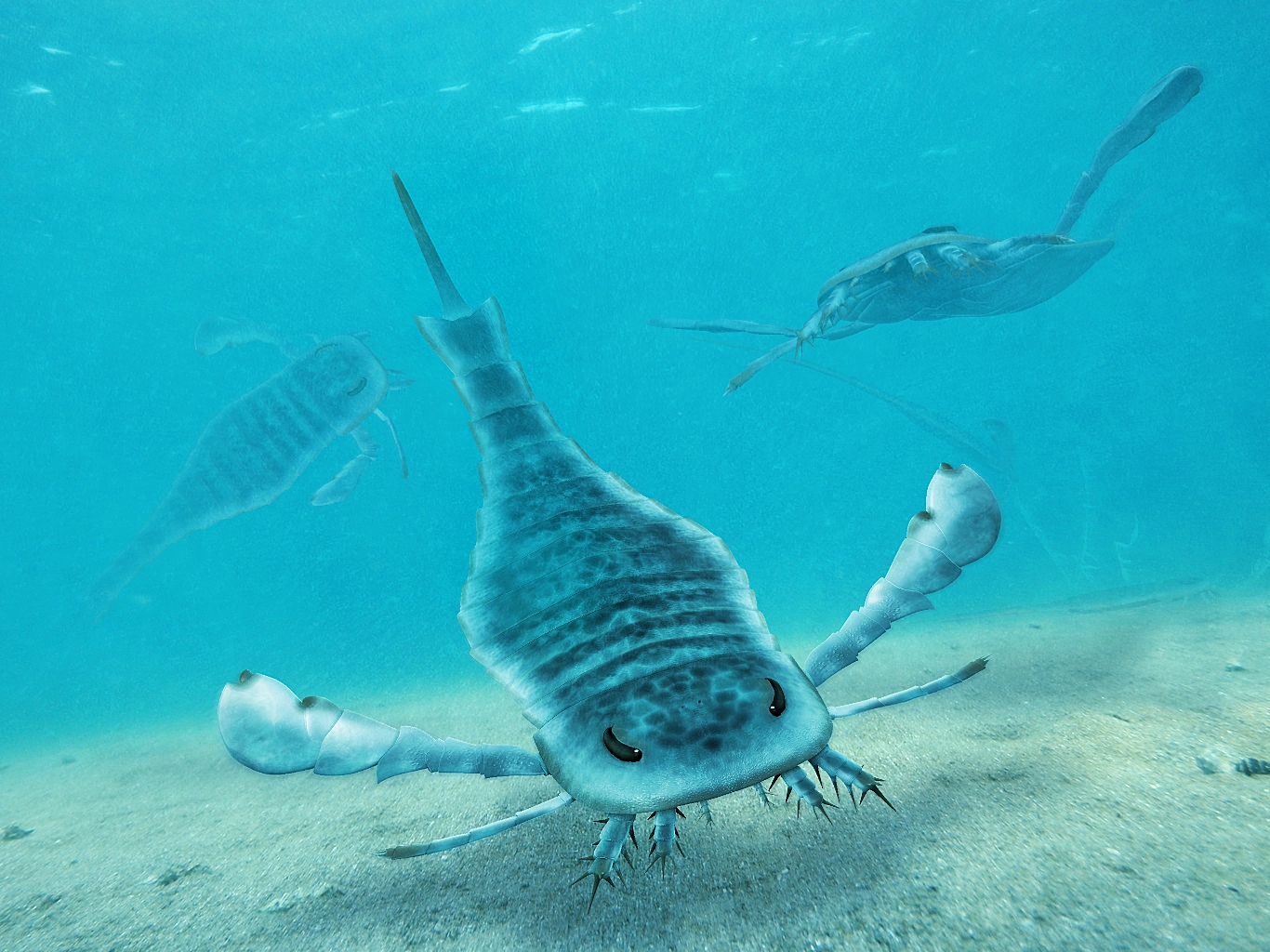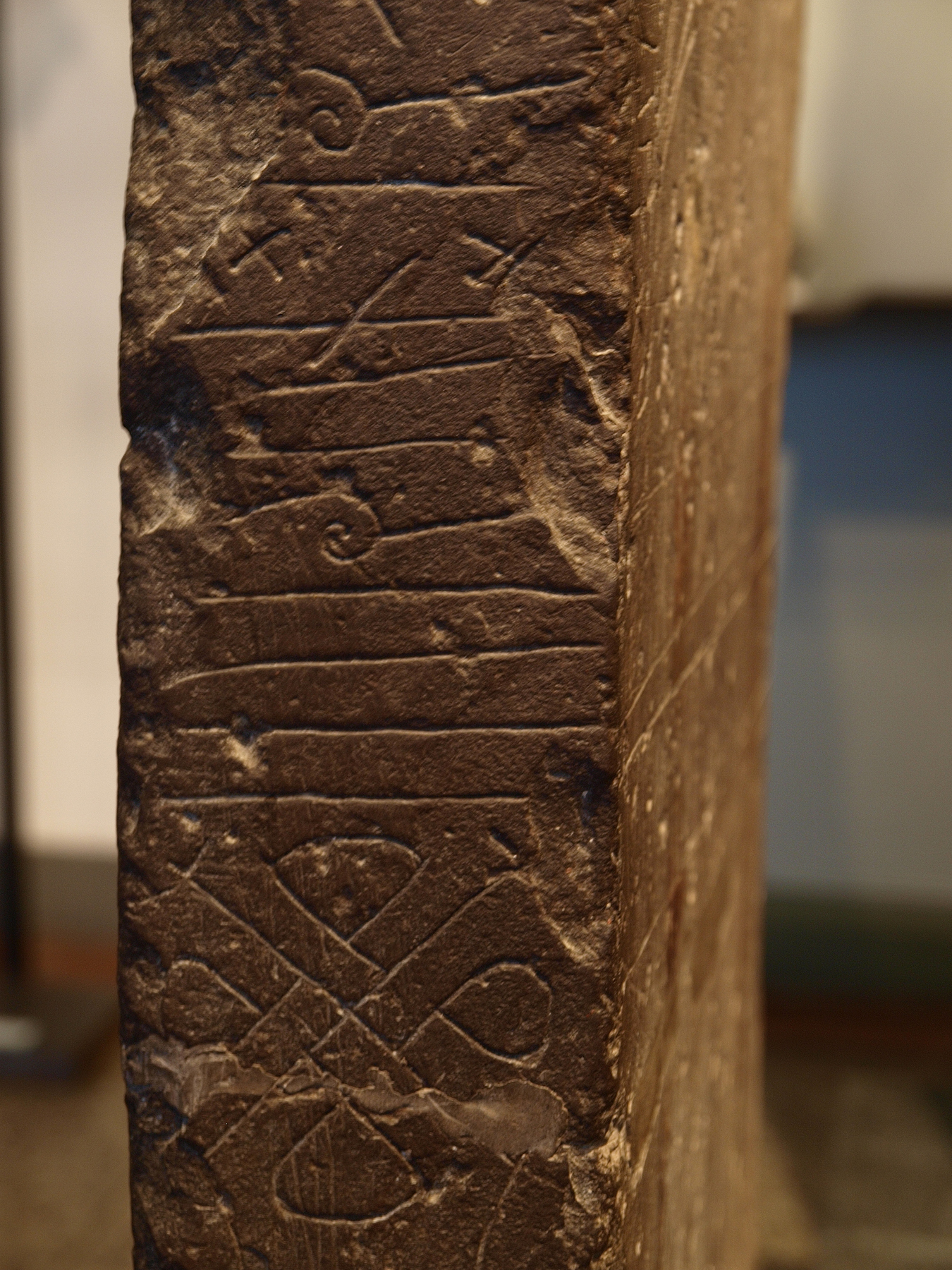|
Mixopterus Kiaeri
''Mixopterus'' is a genus of eurypterid, an extinct group of aquatic arthropods. Fossils of ''Mixopterus'' have been discovered in deposits from Late Silurian age, and have been referred to several different species. Fossils have been recovered from two continents; Europe and North America.Dunlop, J. A., Penney, D. & Jekel, D. 2015. A summary list of fossil spiders and their relatives. In World Spider Catalog. Natural History Museum Bern, online at http://wsc.nmbe.ch, version 18.5 http://www.wsc.nmbe.ch/resources/fossils/Fossils18.5.pdf (PDF). Description ''Mixopterus'' was a medium-sized predatory eurypterid. The largest species, ''M. simonsoni'', reached lengths of 75 cm (29.5 in). It was characterised by a robust exoskeleton with scattered tubercles or semicircular scales. The prosoma (head) was subquadrate, protruding antemedially. The chelicerae (claws in front of the mouth) were small. The two first pairs of legs of ''Mixopterus'' (appendages II and III) were highly spec ... [...More Info...] [...Related Items...] OR: [Wikipedia] [Google] [Baidu] |
Rudolf Ruedemann
Rudolf Ruedemann (October 16, 1864–June 18, 1956) was a German American paleontologist, widely known as an expert in graptolites, enigmatic fossil animals. He worked at the New York State Museum for over 40 years, including a decade as State Paleontologist of New York. and was elected to the U.S. National Academy of Sciences in 1928. Born in Georgenthal, Germany, he was educated in Europe, earning a PhD in 1887 from the University of Jena (Ph.D., 1887), and a second doctorate in 1889 from the University of Strasbourg where he was an assistant in geology from 1887 to 1892. He emigrated to the United States in 1892 and taught at the high schools of Lowville and Dolgeville, New York for several years before joining the State Museum in 1899, where he worked for the remainder of his career. Although his primary interests were in graptolites he also made contributions to other areas of invertebrate paleontology, describing new species of fossil corals, eurypterids ("sea scorpion ... [...More Info...] [...Related Items...] OR: [Wikipedia] [Google] [Baidu] |
Eurypterina
Eurypterina is one of two suborders of eurypterids, an extinct group of chelicerate arthropods commonly known as "sea scorpions". Eurypterine eurypterids are sometimes informally known as "swimming eurypterids". They are known from fossil deposits worldwide, though primarily in North America and Europe. Seventy-five percent of eurypterid species are eurypterines; this represents 99% of specimens. The superfamily Pterygotioidea is the most species-rich clade, with 56 species, followed by the Adelophthalmoidea with 43 species; as sister taxa, they comprise the most derived eurypterines. Pterygotioidea includes the pterygotids, which are the only eurypterids known to have a cosmopolitan distribution. Though more numerous both in specimens and taxa, the eurypterines have the shorter temporal range of the two eurypterid suborders. They first appeared around the same time as the Stylonurina in the Middle Ordovician. The suborder faced a slow extinction during the Middle and Late Devo ... [...More Info...] [...Related Items...] OR: [Wikipedia] [Google] [Baidu] |
Carcinosomatoidea
Carcinosomatoidea is an extinct superfamily of eurypterids, an extinct group of chelicerate arthropods commonly known as "sea scorpions". It is one of the superfamilies classified as part of the suborder Eurypterina. Some carcinosomatoid genera have been suggested to have been fully marine as opposed to living in near-shore brackish or hypersaline environments. The majority of carcinosomatoid taxa are known from the paleocontinents of Laurentia, Baltica and Avalonia. Isolated and fragmentary fossils from the Late Silurian of Vietnam and the Czech Republic show that the terranes of Annamia and Perunica were within the geographical range of the carcinosomatoids. Only a few basal carcinosomatoids (e.g. ''Carcinosoma'' and '' Paracarcinosoma'') have been found in deeper waters whilst the more derived forms, such as '' Mixopterus'' and ''Lanarkopterus'' have not. Basal carcinosomatoids (Carcinosomatidae) are likely responsible for the fossil remains in Vietnam and the Czech Republic ... [...More Info...] [...Related Items...] OR: [Wikipedia] [Google] [Baidu] |
Pterygotioidea
Pterygotioidea (the name deriving from the type genus ''Pterygotus'', meaning "winged one") is a superfamily of eurypterids, an extinct group of aquatic arthropods. Pterygotioids were the most derived members of the infraorder Diploperculata and the sister group of the adelophthalmoid eurypterids. The group includes the basal and small hughmilleriids, the larger and specialized slimonids and the famous pterygotids which were equipped with robust and powerful cheliceral claws. Though the more primitive hughmilleriids were small, '' Hughmilleria wangi'' being the smallest of all pterygotioids at just in length, later members of the group, particularly in the Pterygotidae, would become the largest known arthropods to ever exist with several genera surpassing in length. Among all currently recognized eurypterid clades, the Pterygotioidea is the most diverse, containing over 50 species in 10 genera. With the number of recognized eurypterid species being around 250, pterygotio ... [...More Info...] [...Related Items...] OR: [Wikipedia] [Google] [Baidu] |
List Of Eurypterid Genera
This list of eurypterid genera is a comprehensive listing of all genera that have ever been included in the order Eurypterida, excluding purely vernacular terms. The list includes all commonly accepted genera, but also genera that are now considered invalid, doubtful (''nomen dubium''), or were not formally published (''nomen nudum''), as well as junior synonyms of more established names and genera that are no longer considered eurypterids. The list currently includes 115 names out of which 74 are considered valid eurypterid genera. There are approximately 250 species of eurypterids recognized as valid. Naming conventions and terminology There is no "official" or "canonical" list of eurypterid genera. The closest thing is found contained in the regularly updated ''Summary list'' ''of fossil spiders and their relatives'' in the World Spider Catalog. The vast majority of the content of the list below, including the valid genera, preoccupied names, junior synonyms, taxonomical clas ... [...More Info...] [...Related Items...] OR: [Wikipedia] [Google] [Baidu] |
Pterygotus
''Pterygotus'' is a genus of giant predatory eurypterid, a group of extinct aquatic arthropods. Fossils of ''Pterygotus'' have been discovered in deposits ranging in age from Middle Silurian to Late Devonian, and have been referred to several different species. Fossils have been recovered from four continents; Australia, Europe, North America and South America, which indicates that ''Pterygotus'' might have had a nearly cosmopolitan (worldwide) distribution. The type species, ''P. anglicus'', was described by Swiss naturalist Louis Agassiz in 1839, who gave it the name ''Pterygotus'', meaning "winged one". Agassiz mistakenly believed the remains were of a giant fish; he would only realize the mistake five years later in 1844. ''Pterygotus'' was among the largest eurypterids. Isolated fossil remains of a large chelicera (frontal appendage) suggests that the largest known species, ''P. grandidentatus'', reached a body length of . Several other species, notably ''P. impacatus'' at ... [...More Info...] [...Related Items...] OR: [Wikipedia] [Google] [Baidu] |
Merostomichnites
''Merostomichnites'' is an ichnofossil genus, interpreted as a eurypterid trace. Traces produced by this large eurypterid were described from the Silurian and Lower Ordovician, and has been found in Portugal and Norway. The eurypterid trail was found by Hanken and Dr. J. Miller in 1971. The tracks in Norway were likely made by '' Mixopterus kiaeri''.Hanken, N.-M. & Størmer, L. (1975):The trail of a large Silurian eurypterid. ''Fossils and Strata'', No. 4, pp. 255-270, Pl. 1 -3. See also * List of eurypterid genera This list of eurypterid genera is a comprehensive listing of all genera that have ever been included in the order Eurypterida, excluding purely vernacular terms. The list includes all commonly accepted genera, but also genera that are now consider ... References Eurypterida Fossil trackways {{trace-fossil-stub ... [...More Info...] [...Related Items...] OR: [Wikipedia] [Google] [Baidu] |
Ichnogenus
An ichnotaxon (plural ichnotaxa) is "a taxon based on the fossilized work of an organism", i.e. the non-human equivalent of an artifact. ''Ichnotaxa'' comes from the Greek ίχνος, ''ichnos'' meaning ''track'' and ταξις, ''taxis'' meaning ''ordering''.Definition o'ichno'at dictionary.com. Ichnotaxa are names used to identify and distinguish morphologically distinctive ichnofossils, more commonly known as trace fossils. They are assigned genus and species ranks by ichnologists, much like organisms in Linnaean taxonomy. These are known as ichnogenera and ichnospecies, respectively. "Ichnogenus" and "ichnospecies" are commonly abbreviated as "igen." and "isp.". The binomial names of ichnospecies and their genera are to be written in italics. Most researchers classify trace fossils only as far as the ichnogenus rank, based upon trace fossils that resemble each other in morphology but have subtle differences. Some authors have constructed detailed hierarchies up to ichnosupe ... [...More Info...] [...Related Items...] OR: [Wikipedia] [Google] [Baidu] |
Norway
Norway, officially the Kingdom of Norway, is a Nordic country in Northern Europe, the mainland territory of which comprises the western and northernmost portion of the Scandinavian Peninsula. The remote Arctic island of Jan Mayen and the archipelago of Svalbard also form part of Norway. Bouvet Island, located in the Subantarctic, is a dependency of Norway; it also lays claims to the Antarctic territories of Peter I Island and Queen Maud Land. The capital and largest city in Norway is Oslo. Norway has a total area of and had a population of 5,425,270 in January 2022. The country shares a long eastern border with Sweden at a length of . It is bordered by Finland and Russia to the northeast and the Skagerrak strait to the south, on the other side of which are Denmark and the United Kingdom. Norway has an extensive coastline, facing the North Atlantic Ocean and the Barents Sea. The maritime influence dominates Norway's climate, with mild lowland temperatures on the se ... [...More Info...] [...Related Items...] OR: [Wikipedia] [Google] [Baidu] |
Ringerike (traditional District)
Ringerike is a traditional district in Norway, commonly consisting of the municipalities Hole and Ringerike in Buskerud county. In older times, Ringerike had a larger range which went westward to the municipalities Krødsherad, Modum, and Sigdal, also in Buskerud. Ringerike has a rich history that is connected with one of the most notable kings in the history of Norway, the father of King Harald Fairhair Halfdan the Black, who subdued Gandalf, King of Alfheim and half of Vingulmork, and the Dagling clan. Gandalf was possibly the last king of Ringerike, whose name is given to the eponymous King Hring, son of Raum the Old (cf. Romerike), son of Nór (the eponymous ancestor of Norwegians), according to the Sagas of the ancient Northernlands, better known as the Orkneyinga saga. It is possible that this, as the name suggests, was the legendary heartland of the House of Sigurd Hring and Ivar the Wide-Fathoming. There are also many archaeological remains in the area, dating to the med ... [...More Info...] [...Related Items...] OR: [Wikipedia] [Google] [Baidu] |
Lanarkopterus
''Lanarkopterus'' is a genus of prehistoric eurypterid with one recognised species, ''Lanarkopterus dolichoschelus''. ''Lanarkopterus'' was long seen as a species of the closely related '' Mixopterus'', though more complete specimens discovered in the 1960s determined that it differed in several aspects, enough to warrant a separate genus. Specimens of the genus have been recovered from deposits of Late Silurian age in Scotland. Description ''Lanarkopterus'' was a small to moderately large (ranging in size from less than 10 centimeters to over 30 centimeters) mixopterid eurypterid that like its close relative '' Mixopterus'' appeared almost scorpion-like with a broad and trilobed preabdomen, a narrow and tapering postabdomen and a sharped and curved telsonic spine. History of discovery Specimens of ''Lanarkopterus'' were first noted by Peach and Horne (1899) in the Ludlowian fish beds of the Lesmahagow and Hagshaw Hills Silurian inliers in Ayrshire and Lanarkshire, Scotland ... [...More Info...] [...Related Items...] OR: [Wikipedia] [Google] [Baidu] |
Mixopterus Size
''Mixopterus'' is a genus of eurypterid, an extinct group of aquatic arthropods. Fossils of ''Mixopterus'' have been discovered in deposits from Late Silurian age, and have been referred to several different species. Fossils have been recovered from two continents; Europe and North America.Dunlop, J. A., Penney, D. & Jekel, D. 2015. A summary list of fossil spiders and their relatives. In World Spider Catalog. Natural History Museum Bern, online at http://wsc.nmbe.ch, version 18.5 http://www.wsc.nmbe.ch/resources/fossils/Fossils18.5.pdf (PDF). Description ''Mixopterus'' was a medium-sized predatory eurypterid. The largest species, ''M. simonsoni'', reached lengths of 75 cm (29.5 in). It was characterised by a robust exoskeleton with scattered tubercles or semicircular scales. The prosoma (head) was subquadrate, protruding antemedially. The chelicerae (claws in front of the mouth) were small. The two first pairs of legs of ''Mixopterus'' (appendages II and III) were highly spec ... [...More Info...] [...Related Items...] OR: [Wikipedia] [Google] [Baidu] |






